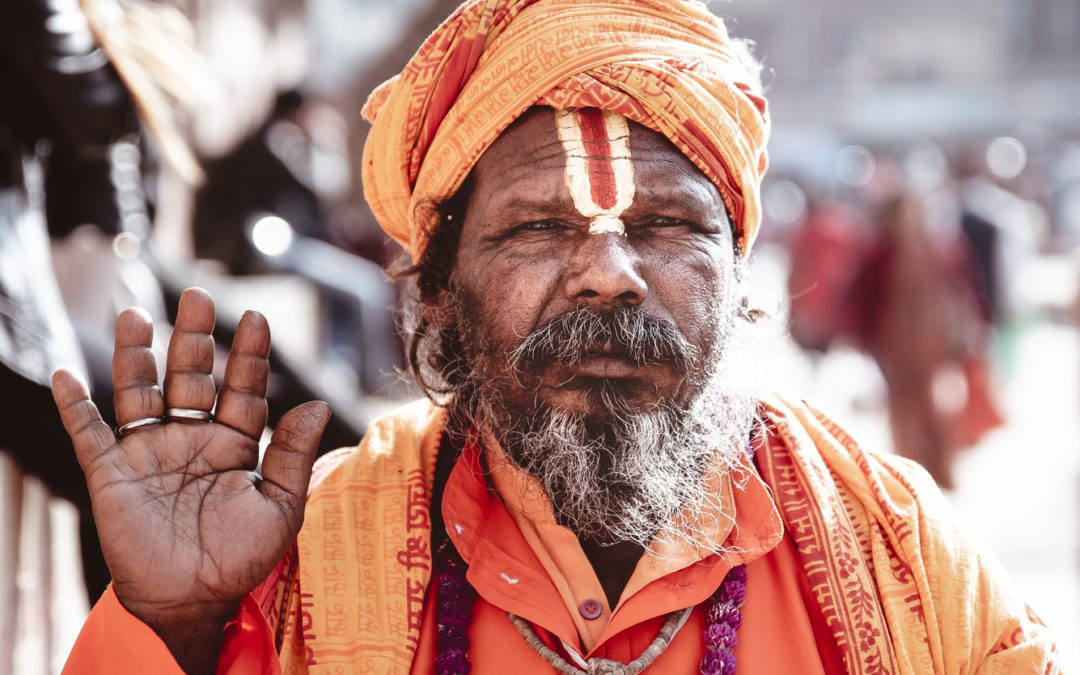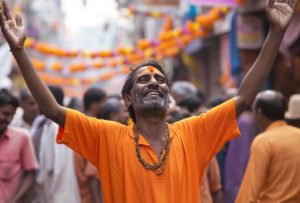
by fyAdmin | Jan 11, 2025 | Religious
The Mahakumbh Mela is not just an event; it is a phenomenon, a convergence of faith, culture, spirituality, and devotion. Held once every 144 years, the Mahakumbh is considered the largest religious gathering on Earth, attracting millions of devotees from across the globe. This grand event is steeped in mythology, history, and tradition, making it a truly unique experience.
Where Does Mahakumbh Happen?
The Mahakumbh Mela is exclusively held in Prayagraj, a city located in Uttar Pradesh, India. Prayagraj, formerly known as Allahabad, is revered as a holy city where the sacred rivers Ganga, Yamuna, and the mythical Saraswati converge. This confluence, known as the ‘Triveni Sangam,’ is believed to be a site of immense spiritual significance, making it the perfect venue for this celestial gathering.
The city transforms into a spiritual epicenter during the Mahakumbh, with vast tent cities, makeshift temples, and ghats constructed to accommodate the throngs of pilgrims and sadhus (ascetics). The aura of devotion and unity at the Triveni Sangam is a testament to the deep-rooted faith that defines India’s cultural ethos.
The Unmatched Qualities of Mahakumbh
Spiritual Magnetism: The Mahakumbh Mela is unparalleled in its ability to draw millions of people, all united by their shared quest for spiritual cleansing and enlightenment. The belief that bathing in the Triveni Sangam during this time absolves one of sins and paves the way to salvation is the event’s most powerful allure.
Cultural Convergence: From saints and seers to common pilgrims and international visitors, the Mahakumbh showcases the diverse spectrum of humanity. The sight of saffron-clad ascetics performing rituals, devotees singing hymns, and scholars debating philosophy creates an ambiance of spiritual harmony.
Largest Temporary City: The Mahakumbh Mela holds the distinction of being the largest temporary city in the world. With state-of-the-art infrastructure, healthcare, security, and waste management systems, the event demonstrates extraordinary organizational capabilities.
Astrological Significance: The timing of the Mahakumbh is determined by celestial alignments. It occurs when Jupiter enters Aquarius (Kumbha Rashi) and the Sun enters Aries (Mesha Rashi), amplifying its sanctity and aligning it with cosmic rhythms.
Why Does the Mahakumbh Happen?
The origins of the Mahakumbh are rooted in Hindu mythology, particularly the story of the churning of the ocean (Samudra Manthan). According to legend, gods (Devas) and demons (Asuras) jointly churned the ocean to obtain Amrit, the nectar of immortality. As they fought over the pot (Kumbh) of Amrit, a few drops spilled at four places—Prayagraj, Haridwar, Ujjain, and Nashik. These locations attained sanctity, inspiring the establishment of the Kumbh Mela to commemorate this celestial occurrence. The Mahakumbh specifically holds a special place, as it is believed to mark the culmination of twelve Purna Kumbh Melas, a cycle that takes 144 years. This grand convergence is thus considered the ultimate spiritual gathering for Hindus.
Read about Ayodhya: https://theblogyfi.com/ram-janmabhoomi-ayodhya/
Aspects of the Mahakumbh
1. The Ritual Bath
The heart of the Mahakumbh’s spiritual practice is the sacred act of bathing (Snan) at the Triveni Sangam, a confluence imbued with divine significance. Devotees believe this act purifies the soul, washes away sins, and helps attain Moksha (liberation). Specific days, known as ‘Shahi Snan’ (Royal Bath), see processions of ascetics and saints leading the bathing rituals.
2. The Akharas and Sadhus
Akharas are monastic orders of ascetics and warriors that play a prominent role in the Mahakumbh. These groups, led by revered saints, engage in processions, prayers, and debates. The Naga Sadhus, characterized by their ash-smeared bodies and renunciation of worldly ties, are among the most iconic participants.
3. Spiritual Discourses and Cultural Events
The Mahakumbh is a hub for spiritual discourses, yoga camps, devotional music, and art exhibitions. Eminent scholars and saints deliver sermons, offering guidance and wisdom to attendees.
4. Religious Harmony and Global Appeal
Though rooted in Hindu tradition, the Mahakumbh welcomes people of all faiths, showcasing its inclusive nature. The event also attracts international visitors, curious to witness and partake in the grandeur of this spiritual phenomenon.
5. Pilgrim Services and Infrastructure
To accommodate millions of visitors, extensive arrangements are made. From transportation and lodging to medical facilities and security, the Mahakumbh demonstrates remarkable efficiency and planning. Temporary pontoon bridges, sanitation systems, and mobile applications enhance the experience for attendees.

The Budget and Planning of Mahakumbh
Organizing an event of such magnitude requires meticulous planning and substantial funding. The budget for the Mahakumbh Mela often runs into thousands of crores of Indian Rupees. The funds are allocated for:
Infrastructure Development: Construction of ghats, roads, tents, and sanitation facilities.
Security: Deployment of police, paramilitary forces, and surveillance systems to ensure safety.
Health Services: Setting up temporary hospitals, ambulances, and emergency services.
Waste Management: Implementing eco-friendly practices to manage waste and maintain cleanliness.
Public Amenities: Providing free drinking water, food distribution centers, and information kiosks.
Estimated Budget
The budget for the Mahakumbh is estimated to be in the range of INR 4,000 to 5,000 crore (approximately $500-600 million USD). However, this is an approximation, and the actual expenses may vary based on unforeseen requirements and contingencies. It is important to note that these figures are based on prior events and expert opinions.
Conclusion
The Mahakumbh Mela is not just a religious event; it is a cultural legacy that exemplifies the richness and diversity of Indian traditions. Its ability to unite millions of people, regardless of their backgrounds, speaks volumes about the enduring power of faith and spirituality.
As humanity’s grandest convergence, the Mahakumbh embodies the enduring principles of togetherness, unwavering devotion, and profound respect for the natural world. Whether you’re a pilgrim seeking divine blessings or a visitor drawn by curiosity, the Mahakumbh offers an unparalleled experience that lingers in the heart and soul. Truly, it is the world’s sacred gathering, a testament to the profound spiritual heritage of India.
Sources

by fyAdmin | Oct 2, 2024 | Education, Health, Parenting, Sports
In today’s fast-paced, technology-driven society, physical education (PE) is often overlooked, but it plays a critical role in the overall development of students. While academics are essential, a well-rounded education must also focus on the physical, emotional, and social growth of students. Physical education is integral in fostering these areas, offering benefits that extend far beyond physical fitness. PE supports mental health, builds social skills, boosts cognitive performance, and instills life-long healthy habits. This makes it vital for ensuring the holistic growth of students.
Physical Education and Physical Health
One of the most obvious benefits of physical education is its impact on physical health. With children today spending more time sitting and engaging in sedentary activities, such as screen time, obesity rates and related health issues like diabetes and cardiovascular disease are rising. PE provides a structured opportunity for students to be active, helping them maintain a healthy weight, build muscle strength, and improve their cardiovascular endurance.
Furthermore, physical education teaches students the importance of making healthy lifestyle choices. Through fitness activities, students learn how to incorporate exercise into their daily routines, establishing habits that can last into adulthood. Engaging in regular physical activity can reduce the risk of lifestyle-related illnesses later in life, setting the foundation for a healthier future.
For more information on how physical activity can prevent health issues, check out this resource from the Centers for Disease Control and Prevention (CDC).
Physical Education and Mental Well-Being
Physical education is also deeply linked to mental health. Participating in regular physical activities triggers the release of endorphins, also known as “feel-good” hormones, which can significantly reduce stress, anxiety, and depression. These benefits make PE an important part of maintaining emotional well-being for students.
In addition to improving mood, physical activities offer a productive way to relieve stress. As students juggle academic pressures, extracurriculars, and social obligations, PE provides an essential outlet to release tension. This can lead to improved self-esteem and emotional resilience, helping students manage challenges both inside and outside the classroom.
For further reading on the mental health benefits of physical activity, this Harvard Medical School article offers great insights.
How Physical Education Enhances Academic Performance
Research consistently shows a strong correlation between physical education and improved academic performance. Exercise boosts brain function by increasing blood flow and oxygen to the brain, enhancing memory, focus, and problem-solving skills. Studies have shown that students who engage in regular physical activity often perform better academically, particularly in subjects like math and science.
PE also gives students much-needed mental breaks from their studies. By engaging in physical activity, students return to their academic tasks feeling refreshed and recharged, which can improve their concentration and productivity. This balance between physical activity and academics contributes to better overall performance in school.
Check out this research by the National Institutes of Health (NIH) for a more in-depth look at how exercise impacts cognitive function.
Social Skills Development through Physical Education
One of the underrated aspects of physical education is its role in fostering social skills. Many activities in PE involve teamwork, cooperation, and communication, allowing students to interact with their peers in ways that promote relationship-building and emotional intelligence. Group activities in PE provide opportunities for students to work together towards common goals, developing skills like leadership, empathy, and conflict resolution.
In these collaborative settings, students learn how to express their ideas clearly, listen to others, and contribute to team success. These experiences are invaluable for preparing students for future relationships, both personal and professional.
For more on the role of teamwork in education, explore this Edutopia article that highlights the importance of collaboration.
Physical Education and Confidence Building
Physical education plays a significant role in boosting self-confidence and self-esteem. Whether it’s improving in a sport, mastering a new skill, or reaching a fitness goal, students gain a sense of accomplishment through PE. This sense of achievement fosters confidence, helping students believe in their abilities.
PE also encourages students to step outside their comfort zones and try new things, which builds resilience and self-belief. These traits extend beyond physical activity, empowering students to face challenges in other areas of life, such as academics and social situations.
Discipline and Responsibility through Physical Education
Another critical aspect of physical education is that it instills discipline and responsibility. PE classes typically have structured routines, clear objectives, and established rules that students must follow. Adhering to these rules teaches students about accountability, perseverance, and time management, skills that are essential for both academic and personal success.
The consistent practice and discipline required in sports and physical activities translate into other areas of life, helping students become more responsible and goal-oriented.
Lifelong Healthy Habits Taught by Physical Education
Perhaps one of the most valuable long-term benefits of physical education is the promotion of lifelong healthy habits. Students who engage in regular physical activity during school are more likely to continue these habits as they age. PE programs not only emphasize the importance of physical fitness but also teach students about nutrition, hydration, and overall well-being.
By learning how to take care of their bodies at a young age, students are equipped with the tools they need to lead balanced and healthy lives. These lessons extend well beyond their school years, influencing their future lifestyle choices and overall health.
Challenges Facing Physical Education
Despite its numerous benefits, physical education faces challenges in many school systems. Budget constraints, lack of resources, and the increasing focus on standardized academic testing often push PE to the sidelines. Schools struggle to allocate time and funding for quality PE programs, which can lead to fewer opportunities for students to engage in physical activity.
Moreover, not all students are equally inclined toward physical activities, making it a challenge for educators to create programs that cater to varying interests and skill levels. Ensuring that PE is inclusive and accessible to all students, regardless of their abilities, is crucial for its success.
Conclusion
Physical Education is Essential for Holistic Growth
Physical education is a vital part of a student’s overall development, promoting physical health, mental well-being, cognitive growth, and social skills. It also fosters emotional resilience, self-discipline, and confidence while encouraging lifelong healthy habits.
In an era where sedentary behaviors are becoming more prevalent, it is essential for schools to prioritize robust and inclusive PE programs. Doing so will equip future generations with the tools they need to lead healthy, productive, and socially responsible lives.
By recognizing the indispensable value of physical education, educators can ensure that students receive a well-rounded education that prepares them for the challenges of life.
For further insights into the role of physical activity in student development, check out this comprehensive guide from Shape America, a leading organization in promoting health and physical education.

by fyAdmin | Jul 21, 2024 | Sports
The Paris Olympics, scheduled to take place in 2024, are set to be a spectacular event, bringing together athletes from around the world to compete in a diverse range of sports. This event marks the third time Paris will host the Olympics, with previous editions in 1900 and 1924. As preparations intensify, anticipation is building for what promises to be a memorable celebration of global athleticism.
Top Ten Participating Nations
The Paris Olympics will see participation from numerous countries, but some stand out due to their large contingents and strong historical performances. Here are the top ten participating nations, including the number of athletes qualified so far:
- United States: The U.S. traditionally sends one of the largest teams. For the Paris Olympics, they have qualified over 600 athletes, making them a formidable force across numerous sports.
- China: China is another powerhouse in the Olympics. They have qualified approximately 500 athletes, excelling in sports like gymnastics, diving, and table tennis.
- Russia: Despite recent controversies, Russian athletes continue to perform at a high level. Around 450 Russian athletes are expected to compete in Paris.
- Japan: Riding high from hosting the Tokyo 2020 Olympics, Japan has qualified nearly 400 athletes, showcasing their strengths in sports like judo and baseball.
- Germany: Germany, with a rich Olympic history, has qualified about 350 athletes, particularly strong in sports like rowing and equestrian events.
- Australia: Known for their prowess in swimming and athletics, Australia has approximately 300 athletes set to compete in Paris.
- Great Britain: Great Britain continues to be a top competitor with around 300 athletes qualified, excelling in cycling, rowing, and athletics.
- France: As the host nation, France is expected to field a large team with around 400 athletes, aiming to shine in sports like fencing and handball.
- Italy: Italy has qualified roughly 280 athletes, known for their strengths in fencing, gymnastics, and swimming.
- India: India, on the rise in the global sports arena, has qualified about 250 athletes, particularly in sports like field hockey, shooting, and boxing.
Top Ten Games and Newly Added Games
The Paris Olympics will feature a variety of sports, some of which are traditional favorites while others are newly added to the lineup. Here are the top ten games that are expected to capture the world’s attention, along with newly included sports:
- Athletics: Athletics is always a highlight of the Olympics, featuring track and field events that draw significant global viewership.
- Swimming: Another perennial favorite, swimming events are highly anticipated, showcasing some of the world’s fastest swimmers.
- Gymnastics: Known for its grace and difficulty, gymnastics is a crowd favorite with both artistic and rhythmic disciplines.
- Basketball: With the inclusion of 3×3 basketball, this sport continues to be a major attraction, drawing fans worldwide.
- Soccer (Football): The Olympic soccer tournament, especially the women’s competition, is eagerly followed by millions.
- Tennis: Tennis features top-ranked players from the ATP and WTA tours, making it a must-watch event.
- Boxing: Boxing has a rich Olympic history and continues to be a significant draw for spectators.
- Wrestling: Both freestyle and Greco-Roman wrestling are traditional Olympic sports with passionate followings.
- Cycling: Events like track cycling, road racing, and BMX draw large audiences and showcase incredible athleticism.
- Fencing: Fencing is a sport with deep historical roots in the Olympics and is particularly popular in Europe.
Newly Added Games
The Paris Olympics will also introduce new sports to the Olympic program, reflecting contemporary trends and broadening the appeal of the Games:
- Skateboarding: First introduced in Tokyo 2020, skateboarding returns with its street and park events, attracting a younger audience.
- Surfing: Also debuting in Tokyo, surfing will see athletes compete on the waves of Tahiti, promising an exciting spectacle.
- Sport Climbing: This dynamic and physically demanding sport has been added to showcase speed, bouldering, and lead climbing disciplines.
- Breakdancing: Officially known as “breaking,” this unique addition highlights athleticism, creativity, and the cultural significance of hip-hop.
- 3×3 Basketball: An urban sport with fast-paced games, 3×3 basketball brings a new dimension to the traditional basketball format.
The Paris Olympics Venue Highlights
Paris, known for its historical and cultural significance, will provide a stunning backdrop for the Olympics. Key venues include:
– Stade de France: Hosting the opening and closing ceremonies, as well as athletics events.
– Bercy Arena: A major venue for gymnastics and other indoor sports.
– Palais Omnisports de Paris-Bercy: Another key site for various competitions.
– Champ de Mars: Near the Eiffel Tower, this venue will host beach volleyball, offering iconic views.
– Roland Garros Stadium: Famous for the French Open, it will host tennis matches.
– Place de la Concorde: A central location in Paris that will host urban sports like skateboarding and BMX.
Sustainability and Innovation at the Paris Olympics
The Paris Olympics aims to be the most sustainable Games ever, with a focus on environmental responsibility and innovation. Key initiatives include:
– Reduced Carbon Footprint: Utilizing existing and temporary venues to minimize construction and reduce emissions.
– Sustainable Transportation: Promoting public transport, cycling, and electric vehicles to reduce the environmental impact.
– Renewable Energy: Powering venues with renewable energy sources, such as solar and wind power.
– Waste Reduction: Implementing comprehensive recycling and waste management programs to minimize waste.
The Legacy of the Paris Olympics
The Paris Olympics are expected to leave a lasting legacy, both for the city and the broader global community. Key aspects of this legacy include:
– Increased Sports Participation: Inspiring a new generation of athletes in France and around the world to engage in sports and physical activity.
– Urban Regeneration: Transforming parts of Paris, particularly the Seine-Saint-Denis area, with new infrastructure and community facilities.
– Cultural Exchange: Promoting cultural understanding and global unity through the universal language of sports.
Conclusion
The Paris Olympics promise to be an extraordinary event, celebrating athletic excellence and global unity. With top nations like the United States, China, and India sending strong contingents, the competition will be fierce across a wide range of sports. The inclusion of new games like skateboarding, surfing, and breakdancing reflects the evolving nature of the Olympics, appealing to a broader and younger audience.
As Paris prepares to host the world, the focus on sustainability and innovation sets a new standard for future Games. The legacy of the Paris Olympics will undoubtedly inspire generations to come, fostering a love for sports and a commitment to environmental responsibility. Whether you’re a fan of traditional sports or eager to see the new additions, the Paris Olympics are set to be a memorable celebration of athleticism and global harmony.
For more info: https://olympics.com/en/paris-2024

by fyAdmin | Jul 14, 2024 | Education
The Bhagavad Gita, a revered Hindu scripture comprising 700 verses, unfolds as a profound dialogue set within the epic Mahabharata. It centers on the poignant discourse between Prince Arjuna and Lord Krishna, his divine charioteer and spiritual guide. Here’s a concise summary of its key teachings:
The Gita begins with Prince Arjuna facing a moral dilemma on the battlefield of Kurukshetra. He is reluctant to fight in the war against his own relatives, teachers, and friends. In this moment of crisis, Krishna imparts spiritual wisdom and guidance to Arjuna, addressing the fundamental questions of life, duty, and the nature of reality.
Krishna teaches Arjuna about the concept of dharma (righteous duty) and emphasizes the importance of fulfilling one’s responsibilities without attachment to outcomes. He explains various paths to spiritual realization, including karma yoga (the yoga of selfless action), bhakti yoga (the yoga of devotion), and jnana yoga (the yoga of knowledge).
Here are the top 10 Bhagavad Gita shlokas spoken by Krishna, along with their English and Hindi meanings:
श्लोक 2.47:
– Sanskrit: कर्मण्येवाधिकारस्ते मा फलेषु कदाचन।
– English: You have the right to perform your prescribed duties, but you are not entitled to the fruits of your actions.
– Hindi: तुम्हारा कर्म निष्काम भाव से करना चाहिए, हे अर्जुन, सफलता या असफलता के संग आसक्ति त्यागकर।
श्लोक 2.48:
– Sanskrit: योगस्थः कुरु कर्माणि सङ्गं त्यक्त्वा धनञ्जय।
– English: Perform your duties with detachment, O Arjuna, free from attachment to success or failure.
– Hindi: हे धनञ्जय, सब संग को छोड़कर समत्व में रहकर कर्म कर।
श्लोक 2.50:
– Sanskrit: बुद्धियुक्तो जहातीह उभे सुकृतदुष्कृते।
– English: A person endowed with wisdom casts off here both good and bad deeds.
– Hindi: बुद्धिमान पुरुष यहाँ सुखी और दुःखी कर्म दोनों को त्याग देता है।
श्लोक 2.62:
– Sanskrit: ध्यायतो विषयान्पुंसः सङ्गस्तेषूपजायते।
– English: While contemplating on the objects of the senses, one develops attachment to them.
– Hindi: इन्द्रियों के विषयों पर चिन्तन करते समय उनसे संग उत्पन्न होता है।
श्लोक 2.47:
– Sanskrit: निराशीर्यतचित्तात्मा त्यक्तसर्वपरिग्रहः।
– English: The self-controlled soul, who has renounced all attachments, remains undisturbed in all circumstances.
– Hindi: संयमित चित्त और सर्व संग परित्यागी आत्मा हर परिस्थिति में अशांत नहीं होता।
श्लोक 3.16:
– Sanskrit: एवं प्रवर्तितं चक्रं नानुवर्तयतीह य:।
– English: My dear Arjuna, one who does not follow the wheel of creation set into motion by me, driven by desire, is a false renouncer.
– Hindi: हे अर्जुन, जो मेरे द्वारा प्रवृत्त रचना-चक्र का अनुसरण नहीं करता, वह कामना से प्रेरित अशांति है।
श्लोक 3.27:
– Sanskrit: प्रकृतेः क्रियमाणानि गुणैः कर्माणि सर्वशः।
– English: All activities are carried out by the three modes of material nature. But one who is in knowledge of me engages in devotional service.
– Hindi: सभी कार्य प्राकृतिक गुणों द्वारा किए जाते हैं, परन्तु मेरे ज्ञान में रहने वाला भक्ति में लगा रहता है।
श्लोक 6.5:
– Sanskrit: उद्धरेदात्मनात्मानं नात्मानमवसादयेत्।
– English: Let a man lift himself by himself; let him not degrade himself; for the self alone is the friend of oneself, and the self alone is the enemy of oneself.
– Hindi: आत्मा को आत्मा से उद्धार करे, आत्मा को अपमानित नहीं करे; क्योंकि केवल आत्मा ही आत्मा का मित्र है और केवल आत्मा ही आत्मा का शत्रु है।
श्लोक 9.22:
– Sanskrit: अनन्याश्चिन्तयन्तो मां ये जना: पर्युपासते।
– English: Those who constantly worship me with exclusive devotion, meditating on my transcendental form, to them I carry what they lack and preserve what they have.
– Hindi: वे लोग जो अनन्य भाव से मेरी ध्यानभक्ति करते हैं, मेरे अन्तर्मुख स्वरूप को ध्यान करते हैं, उनके लिए मैं वह सब उपलब्ध करता हूँ जो उन्हें अभाव में होता है और वह सुरक्षित रखता हूँ जो उनके पास होता है।
श्लोक 18.66:
– Sanskrit: सर्वधर्मान्परित्यज्य मामेकं शरणं व्रज।
– English: Relinquish all distinctions of faith; surrender solely unto me. I shall absolve you from all repercussions of wrongdoing. Fear not.
– Hindi: सभी धर्मों को त्यागकर मुझमें एकांत शरण ले। मैं तुम्हें सभी पापों से मुक्त कर दूँगा। भय न करो।
The Gita concludes with Arjuna resolving his inner conflict, gaining clarity and courage to fulfill his dharma as a warrior. He embraces his duty with a renewed sense of purpose and devotion to Krishna.
Overall, the Bhagavad Gita is a profound philosophical and spiritual guide that offers timeless wisdom on how to live a fulfilling and purposeful life, harmonizing action with spiritual growth, and attaining inner peace and liberation.
Credit Line: This interpretation and summary acknowledge the teachings and verses of the Bhagavad Gita- https://www.holy-bhagavad-gita.org/

by fyAdmin | Jul 13, 2024 | Education, Parenting
In today’s fast-paced digital age, children are increasingly engrossed in screens, whether on mobile phones, tablets, or computers. While technology has undeniable benefits, there’s growing concern among parents and educators about the excessive use of digital devices by children. One of the most significant worries is the impact of screen time on the development of manners and discipline. Instead of relying on mobile devices to keep children occupied, spending quality time with them can be far more beneficial for teaching essential life skills.
The Importance of Personal Interaction
Human interaction is fundamental to a child’s development. Through interactions with parents, siblings, and peers, children learn to communicate, understand social cues, and develop empathy. When children spend too much time on mobile devices, they miss out on these crucial learning opportunities.
Parents play a vital role in teaching manners and discipline. When you spend time with your children, you can model appropriate behavior, set clear expectations, and provide immediate feedback. For instance, during a family meal, you can teach your children about table manners, such as saying “please” and “thank you,” waiting for their turn to speak, and using utensils properly. These are lessons that a mobile app simply cannot provide.
Building Strong Relationships Through Quality Time
Quality time with your children helps build strong, trusting relationships. When children feel loved and valued, they are more likely to listen to their parents and adhere to the rules set for them. This trust forms the foundation for effective discipline. Children are more likely to follow rules and exhibit good behavior when they understand that these guidelines come from a place of love and concern for their well-being.
Teaching Through Play
Play is an excellent way to teach children important life skills. Through play, children learn about sharing, taking turns, following rules, and dealing with disappointment. Engaging in activities such as board games, sports, or even simple pretend play can be incredibly educational. These activities require children to practice self-control, patience, and cooperation.
For example, playing a game like “Simon Says” can teach children to listen carefully and follow instructions, which are essential components of discipline. Similarly, cooperative games, where children have to work together to achieve a common goal, can teach them about teamwork and respect for others.
Encouraging Creativity and Problem-Solving
Spending time with children also provides opportunities to nurture their creativity and problem-solving skills. When children are given the freedom to explore and create without the constraints of a screen, they develop critical thinking and innovative skills. Activities like building with blocks, drawing, or crafting allow children to express themselves and solve problems independently.
Parents can foster this creativity by providing materials and guidance, but it’s important to let children take the lead in their play. This not only boosts their confidence but also teaches them to think independently and make decisions.
Setting Boundaries and Consistency
Discipline is more effective when it is consistent and clear. Spending time with your children allows you to set and enforce boundaries consistently. When children understand the consequences of their actions, they are more likely to develop self-discipline.
For instance, if a child knows that bedtime is at 8 PM and that there are consequences for staying up late, they are more likely to adhere to the bedtime routine. Consistency in enforcing rules helps children understand the importance of discipline and the reasons behind the rules.
The Dangers of Over-Reliance on Technology
While technology can be educational and entertaining, over-reliance on digital devices can have negative consequences. Excessive screen time has been linked to issues such as poor sleep, behavioral problems, and difficulties with attention and focus. Moreover, children who spend a lot of time on screens may struggle with face-to-face communication and social interactions.
By spending quality time with your children and engaging them in various activities, you can help mitigate these risks. Encourage outdoor play, reading, and hobbies that do not involve screens. This not only promotes physical health but also provides opportunities for learning and growth through quality interactions and experiences.
For more insights on the impact of technology, you can read Artificial Intelligence: Boon or Bane?.
For more info https://www.healthychildren.org/
Balancing Screen Time with Real-Life Activities
It’s unrealistic to expect children to completely avoid screens, especially in today’s digital world. However, the key is to find a balance. Set limits on screen time and ensure that children have plenty of opportunities for real-life interactions and activities.
Create a family routine that includes designated times for screen use and times for other activities, such as reading, playing, and spending time outdoors. This balanced approach ensures that children reap the benefits of technology without it overshadowing other important aspects of their development.
Strategies for Reducing Screen Time
1. Establish Tech-Free Zones: Designate certain areas of the home, such as the dining room and bedrooms, as tech-free zones to encourage face-to-face interaction and quality time.
2. Set Screen Time Limits: Use parental controls to set daily screen time limits, ensuring children spend more time on educational, physical activities, and quality time with family.
3. Lead by Example: Parents should model good behavior by limiting their own screen time and engaging in quality time with their children through non-digital activities.
4. Encourage Outdoor Activities: Promote outdoor play and sports to keep children active and away from screens, creating more opportunities for quality time.
Benefits of Reduced Screen Time
1. Improved Behavior: Less screen time can lead to better behavior, as children are more likely to listen and follow instructions when not distracted by devices, allowing for more quality time and meaningful interactions.
2. Better Sleep: Reducing screen time, especially before bed, can improve sleep quality and overall health, leading to more restful and rejuvenating quality time together.
3. Enhanced Social Skills: More face-to-face interaction during quality time helps children develop better social skills, making them more empathetic and understanding.
4. Increased Creativity: Time spent on creative activities during quality time fosters problem-solving skills and innovative thinking.
Conclusion
Spending quality time with your children instead of relying on mobile devices is crucial for teaching manners and discipline. Through personal interaction, play, and consistent boundaries, parents can help their children develop essential life skills. By striking a balance between screen time and real-life activities, you can ensure that your children grow up to be well-rounded, disciplined, and empathetic individuals. In a world increasingly dominated by screens, the value of human connection and personal interaction cannot be overstated.
For more info https://www.healthychildren.org/






